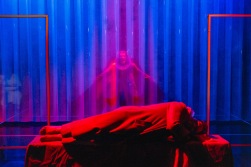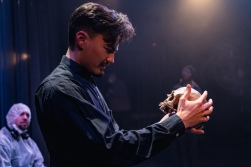Hamlet
by William Shakespeare / Embassy Theatre, 2020 / Film by Illuminations Media / Directed by Ben Naylor / Movement by Ingrid Mackinnon / Design by Max Dorey / Costume by Manuela Harding / Lighting by Ben Jacobs / Sound and composition by Beth Duke / Fights by Rachel Bown-Williams and Bethan Clark for RC-Annie / Stage management by Beth Cotton / Voice by Morwenna Rowe / Film produced by John Wyver / Director of Photography Phil Cooper / Edited by Joe Young
How to respond artistically to an entirely new reality, even while that reality is itself unfolding in newly unanticipated ways? And how to create public performance and showcasing opportunities for a cohort of students whose training had been arrested by the fell sergeant of the coronavirus pandemic? These were the questions I was grappling with through the summer of 2020, and to which this film was the answer.
The challenges the first plague year presented us with in the relatively secure environment of the drama school seem inconsequential, by comparison with the ways in which the pandemic has profoundly affected our theatre, and indeed almost every aspect of our lives. On the Classical MA course at Central, we were also in the incalculably fortunate position of having started to engage with filmed theatre before the pandemic, having collaborated the previous year with John Wyver and Illuminations Media, with whom we’d made Cymbeline 37/19. When it swiftly became apparent that live theatre performance was not on any imminent horizon, I turned to John to see if he’d be willing to collaborate again in order to facilitate a high-quality performance outcome for the 2020 cohort; and graciously and generously, he accepted.
Having spent some months considering what text might best serve as a response to the extraordinary moment – Jonson’s lockdown-set Alchemist was an early contender – it eventually struck me that this infinite and inexhaustible play about mortality was, of course, of course, the perfect instrument: capacious enough to include or admit any theme we wished to explore; and yet in its familiarity enduringly robust, enough to withstand the performance conditions Covid would impose on it.
The realisation that in order to showcase 15 actors in one production I would need to not just double but multi-cast the leading roles (a drama school solution to casting ‘equitability’ I have always hitherto avoided) provided the concept. Hamlet would be played by 13 actors, one for each of the 13 scenes he appears in in the ‘traditional’ layout of the text, and Claudius and Gertrude would be played throughout by the same pair of actors. The casting of all the other roles (bar the Ghost, played in the film by 2014 alumnus Blake Kubena) followed the model of the casting of the protagonist, a different actor taking over each character in each scene; so there were 9 Horatios, 8 Polonius, 6 Laertes, 5 Ophelias and so on. (Rosencrantz and Guildenstern have a particularly intricate and ultimately cyclical casting track through the film.)
This accomplished two simultaneous reframings of the play. One was centralising Claudius, Gertrude and their relationship, as they were the only characters played by the same actors throughout. The other was to force attention on to the acting ensemble, and to the track of each actor as much as to the characters. Great effort was put into creating bespoke tracks for each of the performers which played to their strengths, but contained their own narrative logic or poetry: 1.2’s Polonius becoming 1.3’s Laertes, for instance, or the Gravedigger reappearing as Hamlet in his death scene. This complex casting then did much to define the piece conceptually. Distinct character physicalities, developed with our brilliant movement director Ingrid Mackinnon, helped to unify the performances of the different actors in individual characters, and were subtly heightened by Manuela Harding’s costume choices.
Such a radical casting approach was quite enough conceptual sophistication, but a further reframing was of course enforced upon us. The whole production was created under strict covid regulations: the actors either masked or at 2m distance from each other; shared props had to be sanitised or gloves worn when passing objects; and no physical contact was possible (the fight in the graveyard scene presented a particular challenge, beautifully and stylishly solved by Rachel Bown-Williams and Bethan Clark). I made the decision early on that not only would we not attempt to hide the presence of the pandemic in the production, we would incorporate it throughout and in so far as possible make manifest its impact on the regulation of space and relationships. As was frequently commented on social media during lockdown, plague was endemic in Shakespeare’s society and he took much inspiration from it, at least metaphorically.
The plague is actually bizarrely absent from the early modern stage: I cannot find a single instance of an early modern actor playing the role of someone suffering from plague; perhaps a superstitious taboo (though Petruchio pretends to have it in The Tamer Tamed). And despite its unignorable presence in society, plague also hardly appears as a plot-device in early modern plays. The Alchemist is set in a locked-down townhouse, and there’s the Friar John incident in Romeo and Juliet: scant pickings for such a major feature of early modern life, and given the narrative and thematic richness of early modern drama. Perhaps it is eloquent of the particular terror that plague represented that it is nonetheless metaphorically ubiquitous; and especially for Shakespeare. As such, moments and lines of this well-worn (if not o’erworn) play suddenly struck me that had never done so before, including the strap-line of this film: “Now is the very witching time of night / When churchyards yawn, and Hell itself breathes out / Contagion to this world.”
Given the extreme conditions imposed by the pandemic and by the consequent casting concept, I decided to be very much less radical with the text than I would have been under more ‘normal’ circumstances. As the casting concept was dependent on a particular number of scenes in a particular order, the structure had to be considered inviolable. As such each act and scene is clearly chaptered in the film; though this also reflects an obsession of mine with act structure as a dramaturgical device which is almost always ignored in contemporary presentation of Shakespearean plays. It also reflects the film’s slightly unusual secondary purpose: to provide high-quality showreel material for actors unable to present their work in public; as such, I wasn’t really expecting audiences to watch the whole film in a single sitting. (As a by-product, I also hope this might make the film quite useful in educational settings, as the scenes can easily be isolated for discussion or analysis, heightened by the very diverse young cast shifting roles in each.)
I believe the five-act structure really hasn’t been given the attention it deserves in either scholarship or practice. While act-breaks might not have intruded much in the fluid, demotic performances at the Globe, they would have been critical to the reception of the play indoors at court (and we know categorically both that Hamlet was indeed performed at court; and that act breaks in court performances involved feasting and, inevitably, drinking, the show going on into the early hours). Hamlet is very clearly a play written with the expectation of court performance, and of course it takes place within a court. From the bizarre Christmas allusion in 1.1 to the heightened refraction of the play-within-the-play when both on- and off-stage audiences are courtly, the play’s political daring is heightened if considered in the context of court performance during the traditional Christmas season.
Of course, that’s not replicable now and especially not on screen: instead, the intended effect of this imposition of early modern act breaks on a filmed performance was to make something structured like a mini-series, rather than a movie.
The text we worked with was therefore a composite Q2/F, though not quite full: it was edited for concision and clarity, but not with the particular aim of making it shorter. I knew that with a full eight weeks’ rehearsal we had the opportunity to go pretty deep into a long text; what I was less confident about was how we would shoot all the material in only two days (as it turned out, the answer to this question was two brisk runs of each scene, with a few very limited pick-ups). Otherwise, the process by which this production was made was not at all filmic or televisual: what it really is is a piece of theatre made for an empty theatre, for an absent audience, and then filmed. Some of the more theatrical choices we made (such as the constant presence of the whole ensemble for the first two acts) are almost invisible in the film. The ephemerality of the theatrical form is paradoxically built in to this attempt to record it.
We shot this Hamlet in the empty Embassy Theatre (Central’s historic main house); and the theatre itself, emptied by the pandemic, is the setting. This in itself was both a tragic and a challenging feature of the piece. Is metatheatre even meta if there’s no audience to witness it? The particular chimerical nature of this piece forced us to reframe all of the questions the play asks about the space between performance and reality, about seeming and being.
Making this Hamlet felt momentous. To be involved in making a piece of theatre at a time when the pandemic had wiped out almost all theatrical activity (we rehearsed August-October 2020), was a colossal privilege, and I was aware daily that there but for the grace went I, as social media feeds chronicled the ongoing misery of all my out-of-work friends in the industry. But of course it was also immensely challenging: technically, organisationally, and most particularly emotionally, being responsible for the well-being of a large team at a very frightening moment for all of us. It’s credit to the courage as well as the creativity of the whole cast and crew, that this film exists at all, a record of an attempt to make meaning out of the encounter between Shakespeare and all the challenges of our new reality. What a piece of work.








































































